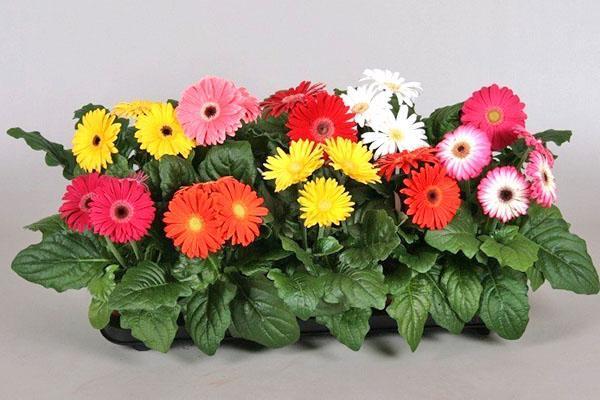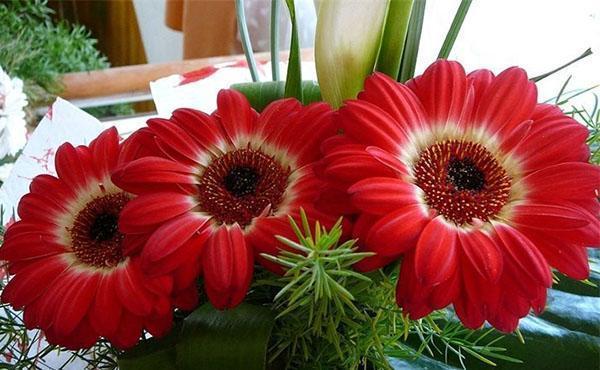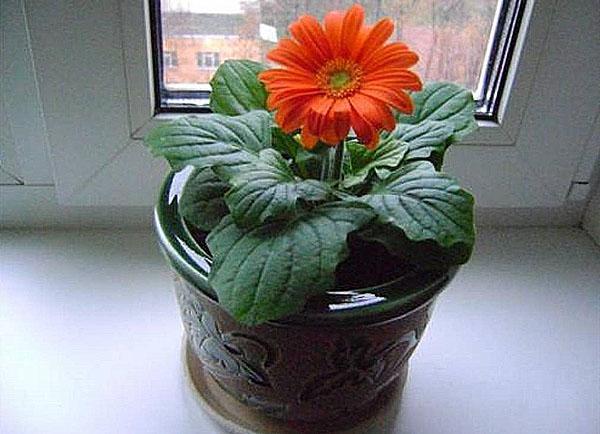Secrets of home care for a room gerbera
 Luxurious flowers of bright colors create a cozy atmosphere even in the most modest interior of a house or apartment. It is the indoor gerbera, for which home care requires certain knowledge, belongs to this type of plant. It is often cultivated on the street or in a greenhouse. However, good lighting and a warm microclimate in the apartment allow households to enjoy its flowering for a long time. There are some secrets of planting, feeding, breeding and caring for this representative of the Astrovs.
Luxurious flowers of bright colors create a cozy atmosphere even in the most modest interior of a house or apartment. It is the indoor gerbera, for which home care requires certain knowledge, belongs to this type of plant. It is often cultivated on the street or in a greenhouse. However, good lighting and a warm microclimate in the apartment allow households to enjoy its flowering for a long time. There are some secrets of planting, feeding, breeding and caring for this representative of the Astrovs.
Landing features

This variety of Astrovs is undersized. Five or seven flowers in one pot will give your home a chic look. You can achieve this result if you choose the right pot. It should be made of clay. Due to the porosity of the material, the roots can breathe. Moreover, it helps to maintain the required temperature in the soil.
 The transplant of purchased copies should be carried out 14-20 days after purchase. During this period, the plant adapts to new conditions. Stems and leaves will become more elastic, raised. When transplanting, consider the following:
The transplant of purchased copies should be carried out 14-20 days after purchase. During this period, the plant adapts to new conditions. Stems and leaves will become more elastic, raised. When transplanting, consider the following:
- the size of the pot is twice the previous one;
- treat the container with boiling water for disinfection;
- completely replace the entire soil, carefully shaking off the temporary soil from the roots;
- young sprouts need top dressing, the frequency of fertilization: at first, every 4-8 days.
 As shown in the photo, caring for a room gerbera at home includes creating favorable conditions for it to flourish. Both in the garden and at home, she does not require special attention to herself.
As shown in the photo, caring for a room gerbera at home includes creating favorable conditions for it to flourish. Both in the garden and at home, she does not require special attention to herself.
Long-term illumination leads to the degeneration of the variety. The plant is depleted and disappears in just 2 years.
Planting soil (transplant)
The soil should be light, which means slightly acidic. Experts do not recommend using as fertilizers compost, as well as humus. You can make nutrient soil yourself. To do this, you need to mix the following components:
- two pieces of deciduous soil;

- 1 part peat;

- one part of sand or sphagnum moss;

- a filler consisting of expanded clay and pine bark.

The condition is of paramount importance - the root outlet should protrude from the ground 1.5-2 cm higher. The transplant should be carried out during the dormant period, when it does not bloom. Otherwise, you can disrupt its natural biorhythm.  If such a charm was presented to the blooming mistress, then there is no need to rush to transplant her. In a small pot, it can grow well for a long period.
If such a charm was presented to the blooming mistress, then there is no need to rush to transplant her. In a small pot, it can grow well for a long period.
It is advised to replant gerbera in early spring or late winter. To do this, you can take a clay pot, the diameter of which is 2-3 cm larger than the previous one. This will allow it to bloom faster.
Lighting requirements
 The most optimal daylight period is 12 hours. Therefore, it is better to choose a place where enough bright sunlight penetrates. In another case, it is allowed that it be scattered. The duration and quality of flowering depends on how you care for indoor gerberas.
The most optimal daylight period is 12 hours. Therefore, it is better to choose a place where enough bright sunlight penetrates. In another case, it is allowed that it be scattered. The duration and quality of flowering depends on how you care for indoor gerberas.  For example, during the summer period it is necessary to take the flowerpot out onto the balcony. If this cannot be done, then the room should be regularly ventilated. The currents of fresh warm air improve the transport of nutrients to the leaves as well as flowers.
For example, during the summer period it is necessary to take the flowerpot out onto the balcony. If this cannot be done, then the room should be regularly ventilated. The currents of fresh warm air improve the transport of nutrients to the leaves as well as flowers.
 From mid-summer to the end of August, this amazing chamomile “throws” all its energy into building up greenery. Since the daylight hours are more than 12 hours, the kidneys simply do not have time to tie. By the end of August, a stormy period of its flowering begins, which lasts until November.
From mid-summer to the end of August, this amazing chamomile “throws” all its energy into building up greenery. Since the daylight hours are more than 12 hours, the kidneys simply do not have time to tie. By the end of August, a stormy period of its flowering begins, which lasts until November.
Temperature and humidity
 Proper care of a room gerbera also includes compliance with temperature limits. Although it is a fairly hardy plant, it should not be overused. Having entered the dormant period, the transvaal chamomile (another name for the flowerpot) may stop blooming altogether. The optimal conditions for growing it are as follows:
Proper care of a room gerbera also includes compliance with temperature limits. Although it is a fairly hardy plant, it should not be overused. Having entered the dormant period, the transvaal chamomile (another name for the flowerpot) may stop blooming altogether. The optimal conditions for growing it are as follows:
- in winter not less than 11-14 ° С;
- in the warm season from 20 to 25 ° С;
- limit the possibility of frequent temperature changes;
- provide relatively high humidity.
It is not recommended to keep the plant on the balcony in winter. Dampness and cold make the gerbera sleepy. Over time, she may die millet.
 The homeland of this flower is Africa (Madagascar Island), as well as Asia. In this regard, it is important to consider that there is a tropical climate in those parts. Therefore, it is best for an indoor gerbera flower to create natural living conditions.
The homeland of this flower is Africa (Madagascar Island), as well as Asia. In this regard, it is important to consider that there is a tropical climate in those parts. Therefore, it is best for an indoor gerbera flower to create natural living conditions.
Watering
 It is extremely dangerous to water the flowerpot with cool water on hot, summer days. Overcooling of the root system will lead to dangerous diseases. In addition, the soil should not dry out. If it is waterlogged, then the root rosette begins to rot. In addition, nematodes - parasitic roundworms that are almost impossible to do away with - can settle in moist soil. The main secret of caring for room gerbera at home lies in the correct technology for its watering, namely:
It is extremely dangerous to water the flowerpot with cool water on hot, summer days. Overcooling of the root system will lead to dangerous diseases. In addition, the soil should not dry out. If it is waterlogged, then the root rosette begins to rot. In addition, nematodes - parasitic roundworms that are almost impossible to do away with - can settle in moist soil. The main secret of caring for room gerbera at home lies in the correct technology for its watering, namely:
- you need to pour on the extreme walls of the container so that the liquid does not get on the roots;
- spray only the leaves daily, because the flowers, unfortunately, do not withstand such water procedures;

- use a pallet. To do this, it is filled with liquid. After 30 minutes, the remaining water is discarded.

Some growers advise to increase watering frequency in such two cases: during the heating season (the air is too dry) and at the end of February. After all, the beginning of March is a period of active growth of the stem and buds.
For watering flowers, you need to use settled water. To do this, they collect liquid in a bottle and leave it in the kitchen for a day, because it is warm there. Then the water temperature will be at least 20 degrees.
Top dressing
 Preference should be given to mineral fertilizers. The indoor gerbera shown in the photo has a very delicate root system, therefore it absolutely does not tolerate organic matter. Humus or compost simply burns off its graceful roots. It should also be borne in mind that for different natural cycles of its development, a certain composition of feeding is needed. In the original, it looks like this:
Preference should be given to mineral fertilizers. The indoor gerbera shown in the photo has a very delicate root system, therefore it absolutely does not tolerate organic matter. Humus or compost simply burns off its graceful roots. It should also be borne in mind that for different natural cycles of its development, a certain composition of feeding is needed. In the original, it looks like this:
- during the rest period (July, August, February and March) use nitrogen-containing fertilizers, this time the gerbera grows only greens;
- during flowering, apply potash dressing;

- when pale spots appear on the leaves, it is important to add magnesium sulfate to the soil (the solution is prepared from 5 liters of water and 10 g of powder);
- there must be gland in the soil, it prevents chlorosis.

Top dressing should not be carried out with highly concentrated solutions. It is worth diluting the drug 2 times with the volume of liquid indicated in the instructions.
Unfortunately, opinions on the frequency of fertilization differ. Some say that this needs to be done in 1-2 weeks, while others claim that one feeding per decade is enough. In connection with such a difference of opinion, each housewife must decide for herself how to care for a room gerbera.Observation will help her in this, as well as simple female intuition. As far as possible, it is necessary to fluff the soil once a week, giving the roots a sufficient dose of oxygen.
Household plant varieties do not need pruning. It is enough just to carefully remove dried flowers or leaves.

Diseases and pests
Nothing frustrates desperate housewives like the disease of room gerbera, because this luxurious plant just melts before our eyes. When the first signs of parasitism appear, you should act immediately. You need to know the following pests by sight:
- Powdery mildew. Cold water or frequent and sudden changes in temperature contribute to powdery mildew. Abuse of nitrogenous supplements can also be a reason.

- Spider mite. Lack of moisture leads to the fact that the leaves dry out and begin to fall off. Fight - spraying 3 times a day. The use of fungicides also kills the tick.

- Mold (white and gray). The water in the soil stagnates, and as a result, fungal stains appear. It is important to cut off affected leaves, sometimes stems, immediately.

- Aphids as well as whitefly. The pest should be eliminated with the help of solutions that include copper (for example, copper sulfate), or insecticides.

- Phytophthora. The reason is that the ground remains wet for a long time.

Although this exotic aster is of tropical origin, excessive humidity can harm it. Therefore, when caring for room gerbera at home, special attention should be paid to the watering and spraying procedure. The result is the rich and gorgeous flowers of the Transvaal daisy.